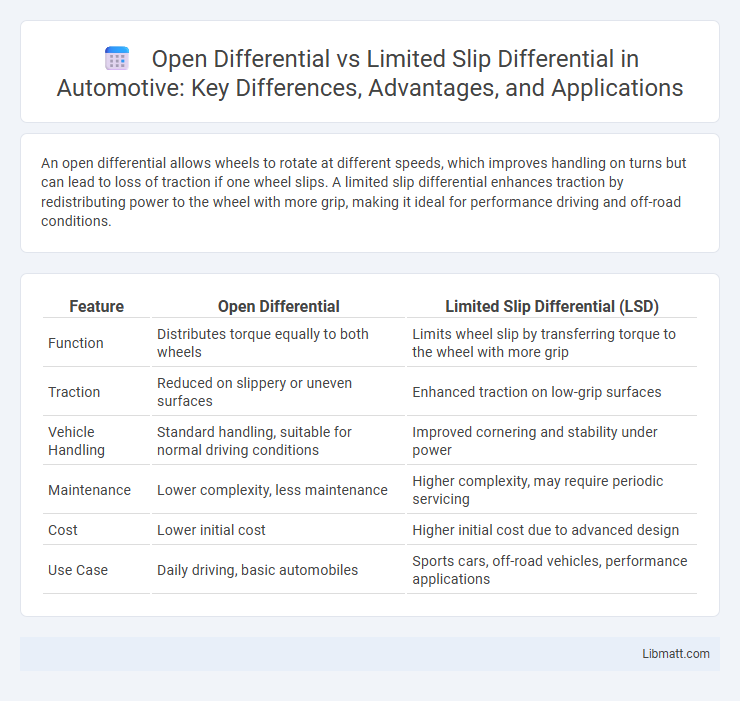An open differential allows wheels to rotate at different speeds, which improves handling on turns but can lead to loss of traction if one wheel slips. A limited slip differential enhances traction by redistributing power to the wheel with more grip, making it ideal for performance driving and off-road conditions.
Table of Comparison
| Feature | Open Differential | Limited Slip Differential (LSD) |
|---|---|---|
| Function | Distributes torque equally to both wheels | Limits wheel slip by transferring torque to the wheel with more grip |
| Traction | Reduced on slippery or uneven surfaces | Enhanced traction on low-grip surfaces |
| Vehicle Handling | Standard handling, suitable for normal driving conditions | Improved cornering and stability under power |
| Maintenance | Lower complexity, less maintenance | Higher complexity, may require periodic servicing |
| Cost | Lower initial cost | Higher initial cost due to advanced design |
| Use Case | Daily driving, basic automobiles | Sports cars, off-road vehicles, performance applications |
Introduction to Vehicle Differentials
Vehicle differentials play a crucial role in allowing wheels to rotate at different speeds, enhancing traction and stability during turns. Open differentials distribute torque evenly to both wheels but can struggle on slippery surfaces, whereas limited slip differentials improve grip by limiting wheel spin through controlled torque transfer. Understanding how these systems affect Your vehicle's handling and performance is essential for optimizing driving safety and efficiency.
What is an Open Differential?
An open differential is a type of automotive differential that allows the wheels to rotate at different speeds, which is essential for smooth turning. It evenly distributes engine torque to both wheels, but if one wheel loses traction, power is transferred primarily to the slipping wheel, reducing overall vehicle traction. Open differentials are common in standard vehicles due to their simplicity and cost-effectiveness but may struggle in low-traction conditions compared to limited slip differentials.
How Does a Limited Slip Differential Work?
A limited slip differential (LSD) works by distributing torque between the wheels to improve traction, especially when one wheel loses grip. It uses clutch packs, gears, or viscous fluids to transfer power from the slipping wheel to the wheel with better traction, preventing excessive wheel spin. This mechanism enhances stability and performance in conditions like cornering, off-road driving, or slippery surfaces compared to an open differential, which sends equal torque to both wheels regardless of traction.
Key Differences Between Open and Limited Slip Differentials
Open differentials distribute torque equally to both wheels, allowing them to rotate at different speeds, which is ideal for smooth cornering on paved roads. Limited slip differentials detect wheel slip and transfer more torque to the wheel with better traction, enhancing grip in off-road or slippery conditions. This torque management in limited slip differentials improves vehicle stability and performance during acceleration and cornering on varied surfaces.
Performance Impacts on Traction and Handling
Open differentials provide consistent power distribution to wheels but struggle with traction on slippery or uneven surfaces, causing one wheel to spin freely and reducing overall grip. Limited slip differentials enhance performance by transferring torque to the wheel with more traction, improving handling and stability during cornering and acceleration. This results in better control and increased traction in challenging driving conditions, making limited slip differentials ideal for performance and off-road vehicles.
Advantages of Open Differentials
Open differentials offer superior maneuverability by allowing each wheel to rotate at different speeds, which is essential for smooth cornering and reducing tire wear. They provide simpler construction and lower cost compared to limited slip differentials, making them a practical choice for everyday vehicles. Their ability to evenly distribute torque to both wheels on an axle enhances drivability on dry, paved surfaces.
Benefits of Limited Slip Differentials
Limited slip differentials provide improved traction by distributing power to the wheel with the most grip, enhancing vehicle stability and control during acceleration and cornering. This system reduces wheel spin on slippery surfaces, making it ideal for off-road driving and performance applications. By optimizing torque distribution, your vehicle gains better handling and safety in challenging driving conditions.
Common Applications in Modern Vehicles
Open differentials are commonly found in standard passenger vehicles and entry-level trucks, providing smooth handling on paved roads by allowing independent wheel rotation. Limited slip differentials are favored in performance cars, SUVs, and off-road vehicles, enhancing traction by distributing torque to wheels with grip during slippery or uneven conditions. Modern all-wheel-drive systems often integrate limited slip differentials to improve stability and control across diverse driving environments.
Choosing the Right Differential for Your Needs
Open differentials provide smooth, consistent power distribution ideal for everyday driving and fuel efficiency, while limited slip differentials enhance traction by distributing torque to the wheel with more grip, making them suitable for performance or off-road conditions. Your choice depends on driving habits, terrain, and performance requirements; limited slip differentials offer better handling and control in slippery or uneven environments. Prioritize the differential type that matches your vehicle usage to optimize stability, safety, and driving experience.
Conclusion: Which Differential Is Better?
An open differential provides smooth, predictable handling on dry, paved roads by allowing wheels to rotate at different speeds, but it struggles with traction on slippery or uneven surfaces. A limited slip differential enhances grip by distributing torque to the wheel with more traction, improving control during acceleration and cornering in challenging conditions. Your choice depends on driving needs: open differentials excel in everyday driving, while limited slip differentials offer superior performance and safety in off-road or high-performance scenarios.
open differential vs limited slip differential Infographic

 libmatt.com
libmatt.com